TOYOTA AVALON 2021 Owners Manual (in English)
Manufacturer: TOYOTA, Model Year: 2021, Model line: AVALON, Model: TOYOTA AVALON 2021Pages: 548, PDF Size: 13.4 MB
Page 301 of 548
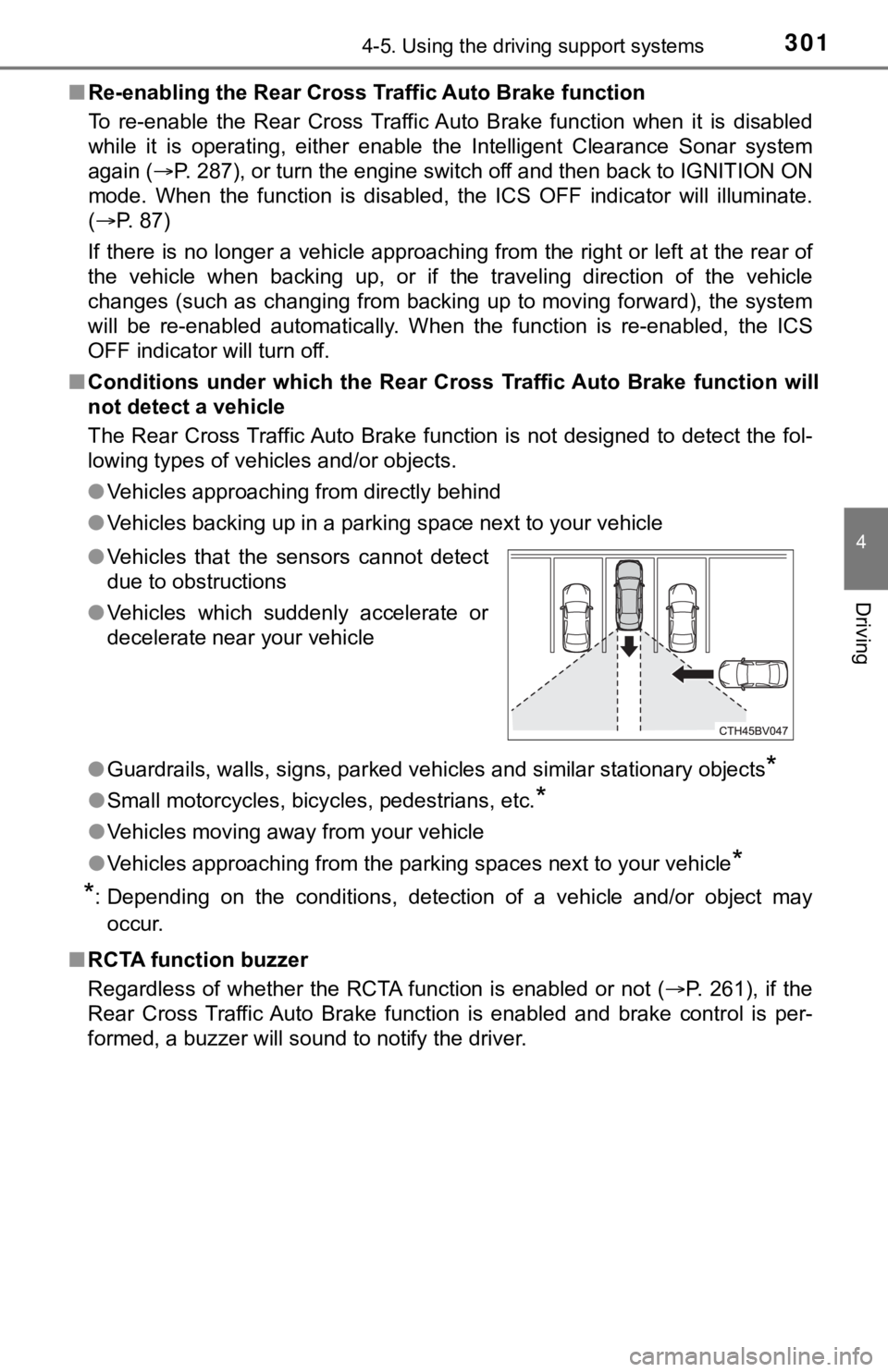
3014-5. Using the driving support systems
4
Driving
■Re-enabling the Rear Cross Traffic Auto Brake function
To re-enable the Rear Cross Traffic Auto Brake function when it is disabled
while it is operating, either enable the Intelligent Clearance Sonar system
again (P. 287), or turn the engine switch off and then back to IGNITION ON
mode. When the function is disabled, the ICS OFF indicator will illuminate.
(P. 87)
If there is no longer a vehicle approaching from the right or left at the rear of
the vehicle when backing up, or if the traveling direction of the vehicle
changes (such as changing from backing up to moving forward), the system
will be re-enabled automatically. When the function is re-enabled, the ICS
OFF indicator will turn off.
■Conditions under which the Rear Cross Traffic Auto Brake function will
not detect a vehicle
The Rear Cross Traffic Auto Brake function is not designed to detect the fol-
lowing types of vehicles and/or objects.
●Vehicles approaching from directly behind
●Vehicles backing up in a parking space next to your vehicle
●<002a005800440055004700550044004c004f0056000f0003005a0044004f004f0056000f00030056004c004a00510056000f0003005300440055004e00480047000300590048004b004c0046004f00480056000300440051004700030056004c0050004c00
4f0044005500030056005700440057004c0052005100440055[y objects
*
●Small motorcycles, bicycles, pedestrians, etc.*
●Vehicles moving away from your vehicle
●Vehicles approaching from the parking spaces next to your vehicle
*
*
: Depending on the conditions, detection of a vehicle and/or object may
occur.
■RCTA function buzzer
Regardless of whether the RCTA function is enabled or not (P. 261), if the
Rear Cross Traffic Auto Brake function is enabled and brake control is per-
formed, a buzzer will sound to notify the driver. ●Vehicles that the sensors cannot detect
due to obstructions
●Vehicles which suddenly accelerate or
decelerate near your vehicle
Page 302 of 548
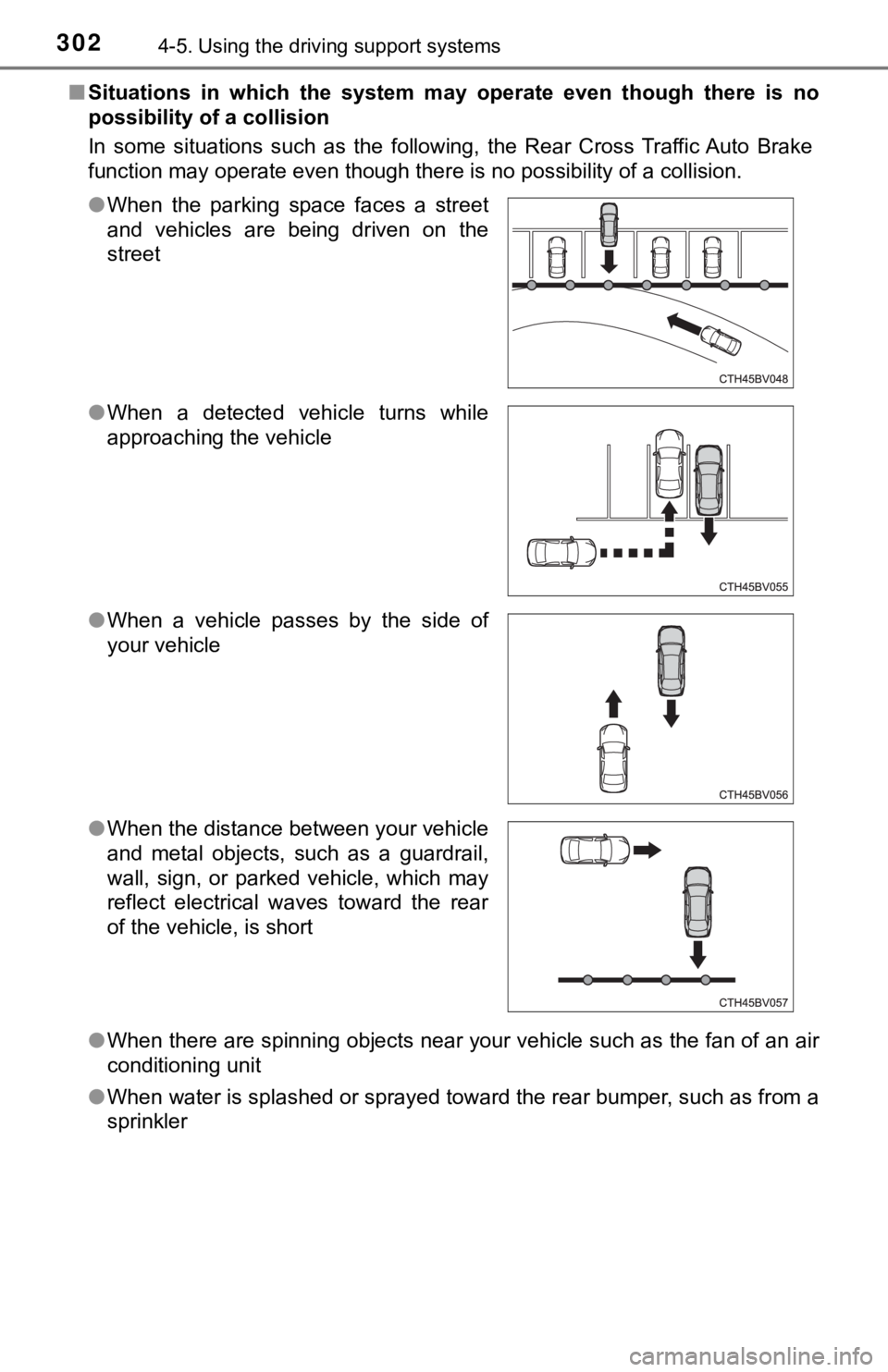
3024-5. Using the driving support systems
■Situations in which the system may operate even though there is no
possibility of a collision
In some situations such as the following, the Rear Cross Traffic Auto Brake
function may operate even though there is no possibility of a collision.
●When there are spinning objects near your vehicle such as the fan of an air
conditioning unit
●When water is splashed or sprayed toward the rear bumper, such as from a
sprinkler ●When the parking space faces a street
and vehicles are being driven on the
street
●When a detected vehicle turns while
approaching the vehicle
●When a vehicle passes by the side of
your vehicle
●When the distance between your vehicle
and metal objects, such as a guardrail,
wall, sign, or parked vehicle, which may
reflect electrical waves toward the rear
of the vehicle, is short
Page 303 of 548
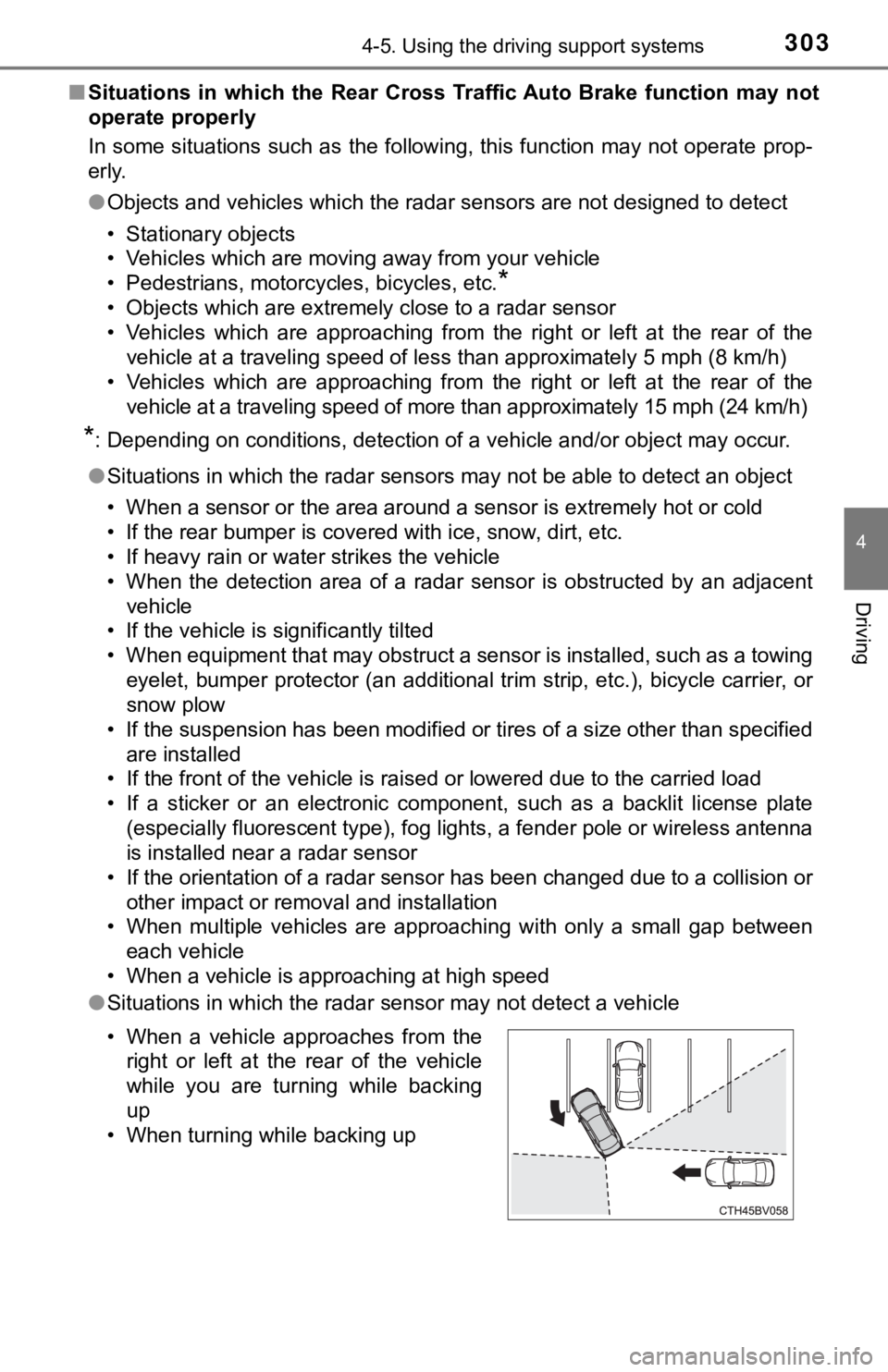
3034-5. Using the driving support systems
4
Driving
■Situations in which the Rear Cross Traffic Auto Brake function may not
operate properly
In some situations such as the following, this function may not operate prop-
erly.
●Objects and vehicles which the radar sensors are not designed to detect
• Stationary objects
• Vehicles which are moving away from your vehicle
• Pedestrians, motorcycles, bicycles, etc.
*
• Objects which are extremely close to a radar sensor
• Vehicles which are approaching from the right or left at the rear of the
vehicle at a traveling speed of less than approximately 5 mph (8 km/h)
• Vehicles which are approaching from the right or left at the rear of the
vehicle at a traveling speed of more than approximately 15 mph (24 km/h)
*: Depending on conditions, detection of a vehicle and/or object may occur.
●Situations in which the radar sensors may not be able to detect an object
• When a sensor or the area around a sensor is extremely hot or cold
• If the rear bumper is covered with ice, snow, dirt, etc.
• If heavy rain or water strikes the vehicle
• When the detection area of a radar sensor is obstructed by an adjacent
vehicle
• If the vehicle is significantly tilted
• When equipment that may obstruct a sensor is installed, such as a towing
eyelet, bumper protector (an additional trim strip, etc.), bicycle carrier, or
snow plow
• If the suspension has been modified or tires of a size other than specified
are installed
• If the front of the vehicle is raised or lowered due to the carried load
• If a sticker or an electronic component, such as a backlit license plate
(especially fluorescent type), fog lights, a fender pole or wireless antenna
is installed near a radar sensor
• If the orientation of a radar sensor has been changed due to a collision or
other impact or removal and installation
• When multiple vehicles are approaching with only a small gap between
each vehicle
• When a vehicle is approaching at high speed
●Situations in which the radar sensor may not detect a vehicle
• When a vehicle approaches from the
right or left at the rear of the vehicle
while you are turning while backing
up
• When turning while backing up
Page 304 of 548
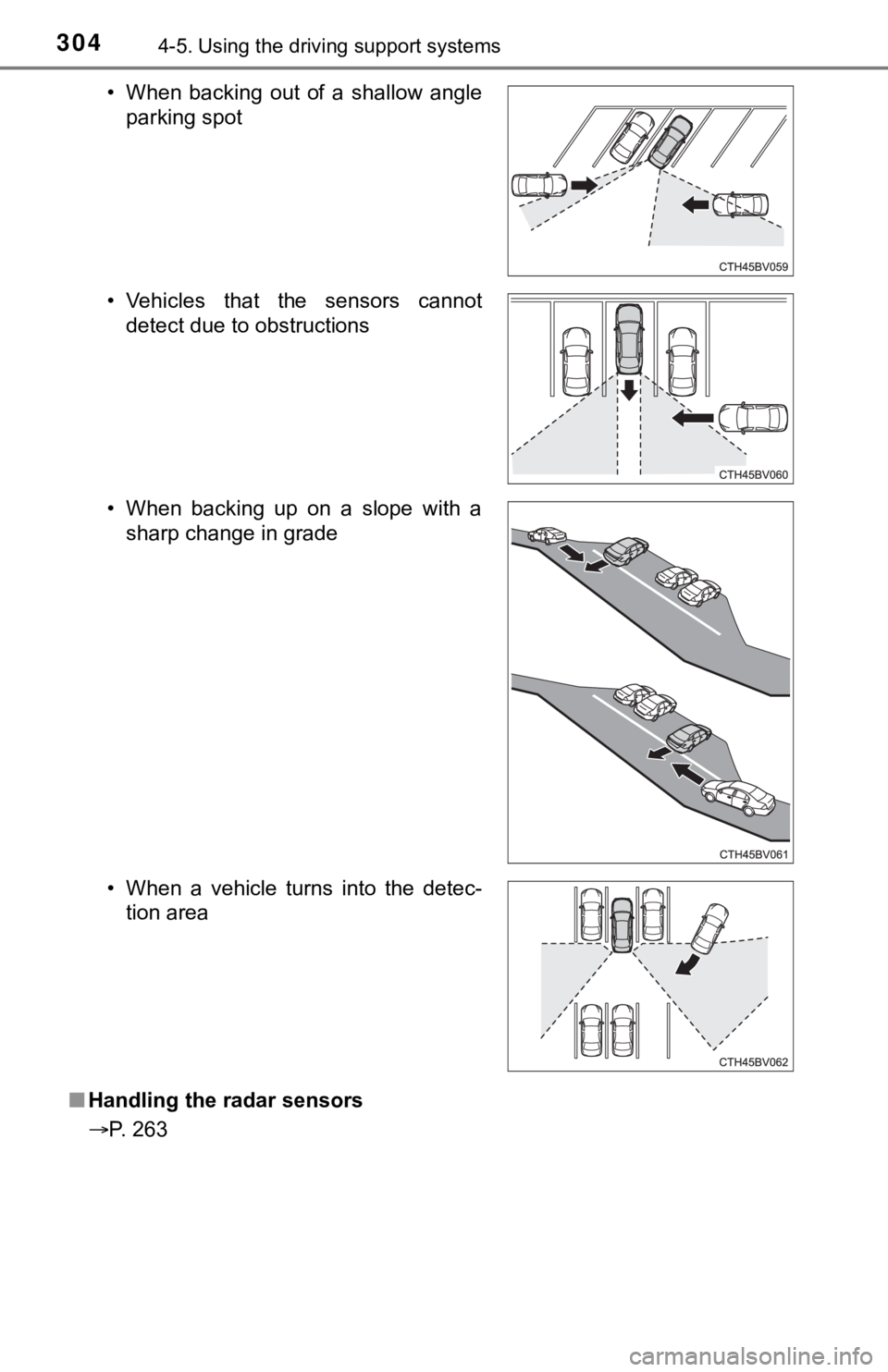
3044-5. Using the driving support systems
■Handling the radar sensors
P. 263 • When backing out of a shallow angle
parking spot
• Vehicles that the sensors cannot
detect due to obstructions
• When backing up on a slope with a
sharp change in grade
• When a vehicle turns into the detec-
tion area
Page 305 of 548
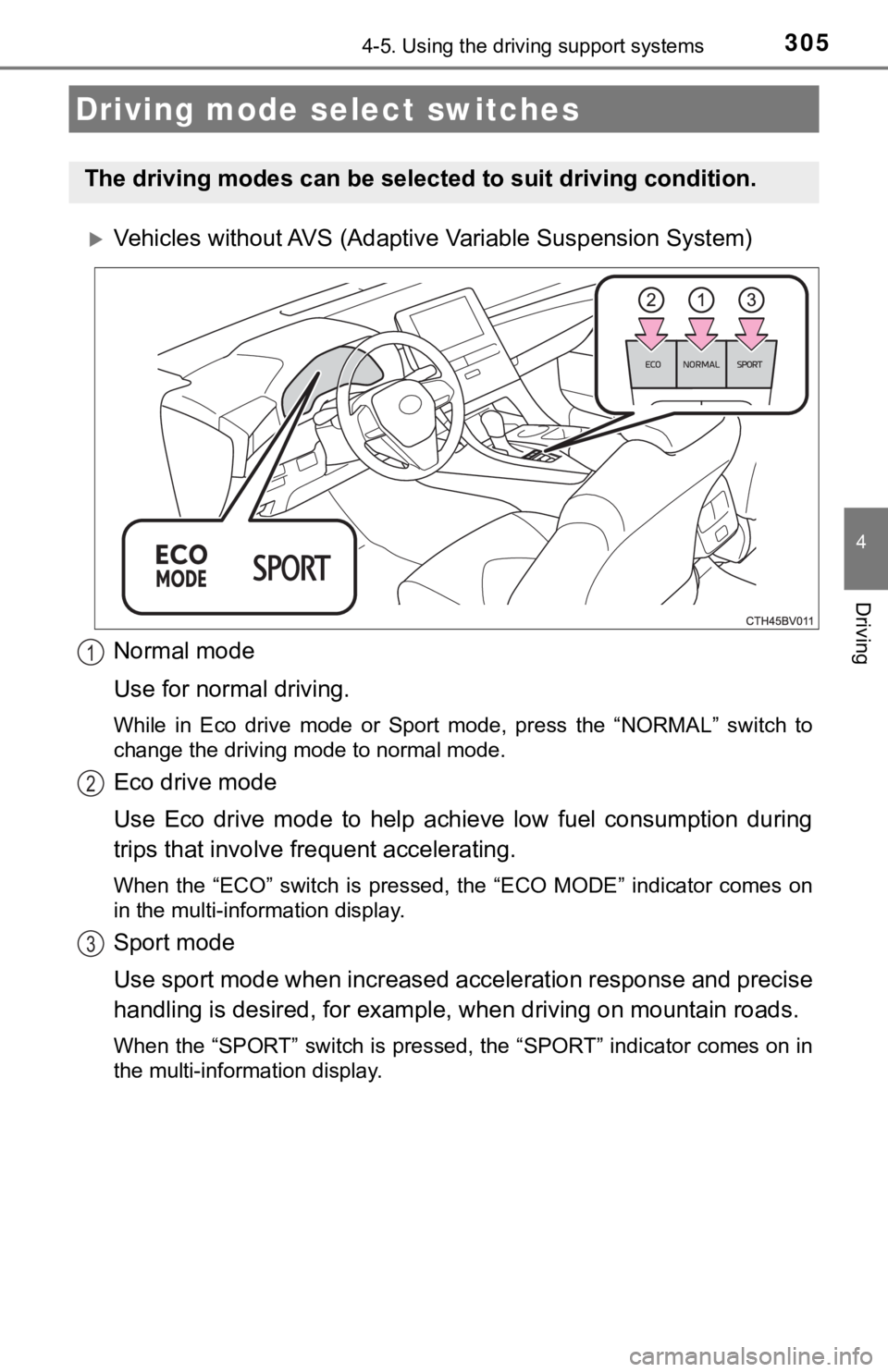
3054-5. Using the driving support systems
4
Driving
Vehicles without AVS (Adaptive Variable Suspension System)
Normal mode
Use for normal driving.
While in Eco drive mode or Sport mode, press the “NORMAL” switch to
change the driving mode to normal mode.
Eco drive mode
Use Eco drive mode to help achieve low fuel consumption during
trips that involve frequent accelerating.
When the “ECO” switch is pressed, the “ECO MODE” indicator comes on
in the multi-information display.
Sport mode
Use sport mode when increased acceleration response and precise
handling is desired, for example, when driving on mountain roads.
When the “SPORT” switch is pressed, the “SPORT” indicator comes on in
the multi-information display.
Driving mode select switches
The driving modes can be selected to suit driving condition.
1
2
3
Page 306 of 548
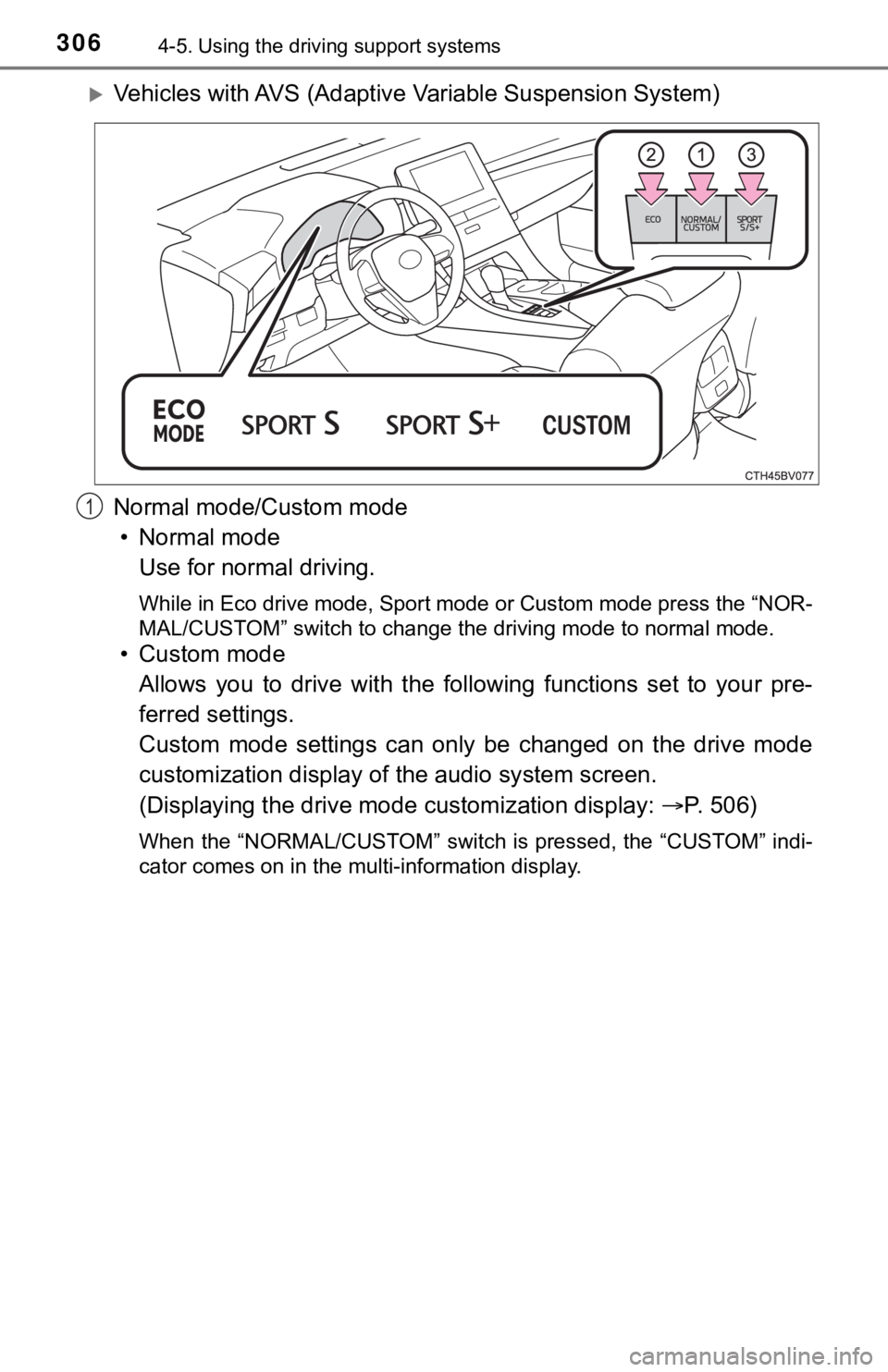
3064-5. Using the driving support systems
Vehicles with AVS (Adaptive Variable Suspension System)
Normal mode/Custom mode
• Normal mode
Use for normal driving.
While in Eco drive mode, Sport mode or Custom mode press the “NOR-
MAL/CUSTOM” switch to change the driving mode to normal mode.
• Custom mode
Allows you to drive with the following functions set to your pre-
ferred settings.
Custom mode settings can only be changed on the drive mode
customization display of the audio system screen.
(Displaying the drive mode customization display: P. 5 0 6 )
When the “NORMAL/CUSTOM” switch is pressed, the “CUSTOM” indi-
cator comes on in the multi-information display.
1
Page 307 of 548
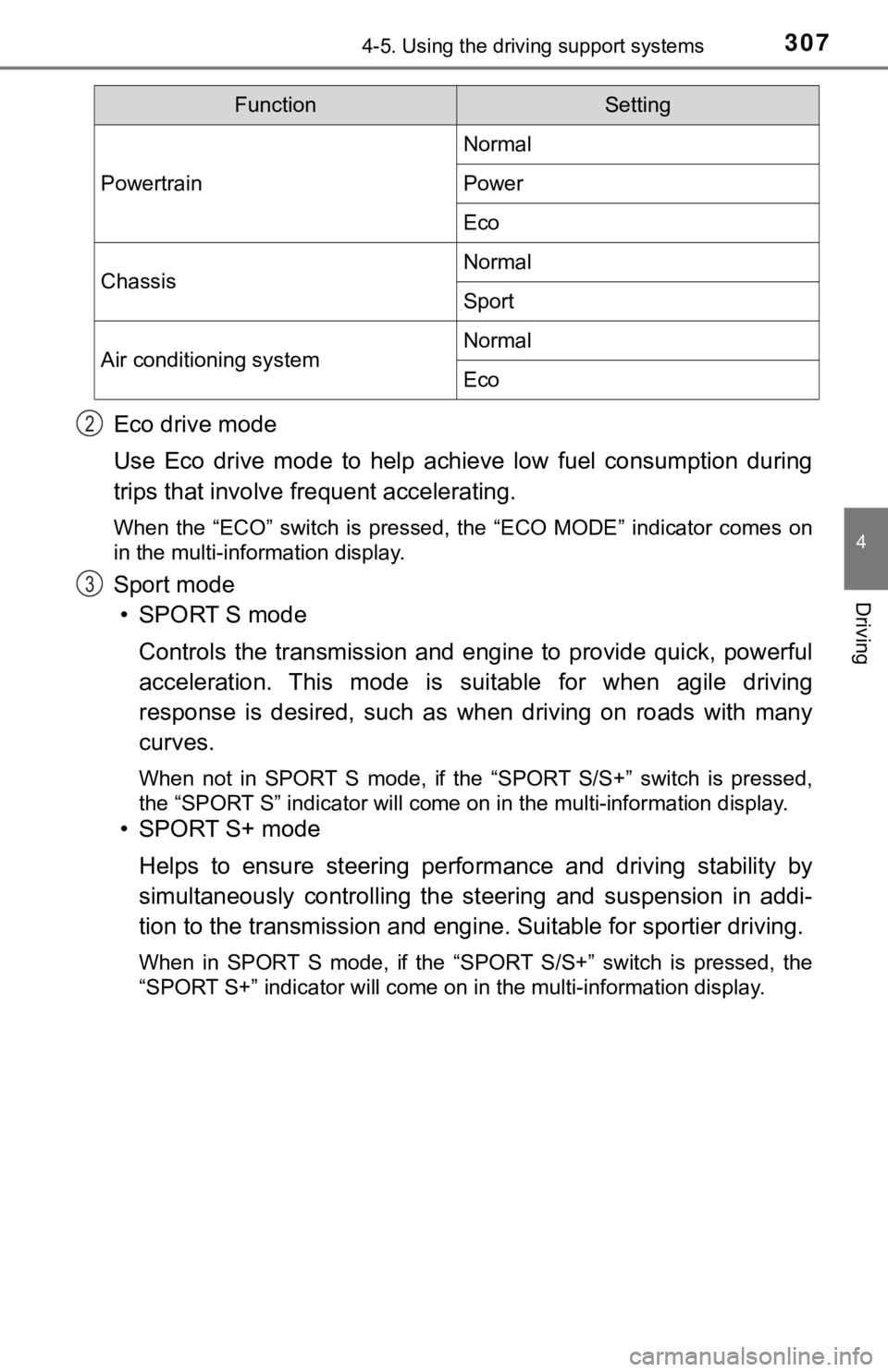
3074-5. Using the driving support systems
4
Driving
Eco drive mode
Use Eco drive mode to help achieve low fuel consumption during
trips that involve frequent accelerating.
When the “ECO” switch is pressed, the “ECO MODE” indicator comes on
in the multi-information display.
Sport mode
• SPORT S mode
Controls the transmission and engine to provide quick, powerful
acceleration. This mode is suitable for when agile driving
response is desired, such as when driving on roads with many
curves.
When not in SPORT S mode, if the “SPORT S/S+” switch is pressed,
the “SPORT S” indicator will come on in the multi-information display.
• SPORT S+ mode
Helps to ensure steering performance and driving stability by
simultaneously controlling the steering and suspension in addi-
tion to the transmission and engine. Suitable for sportier driving.
When in SPORT S mode, if the “SPORT S/S+” switch is pressed, the
“SPORT S+” indicator will come on in the multi-information display.
FunctionSetting
Powertrain
Normal
Power
Eco
ChassisNormal
Sport
Air conditioning systemNormal
Eco
2
3
Page 308 of 548

3084-5. Using the driving support systems
■Operation of the air conditioning system in Eco drive mode
Eco drive mode controls the heating/cooling operations and fan speed of the
air conditioning system to enhance fuel efficiency (P. 322). To improve air
conditioning performance, adjust the fan speed or turn off Eco drive mode.
■Automatic deactivation of sport mode and custom mode
If the engine switch is turned off after driving in sport mode or custom mode,
the drive mode will be changed to normal mode.
Page 309 of 548
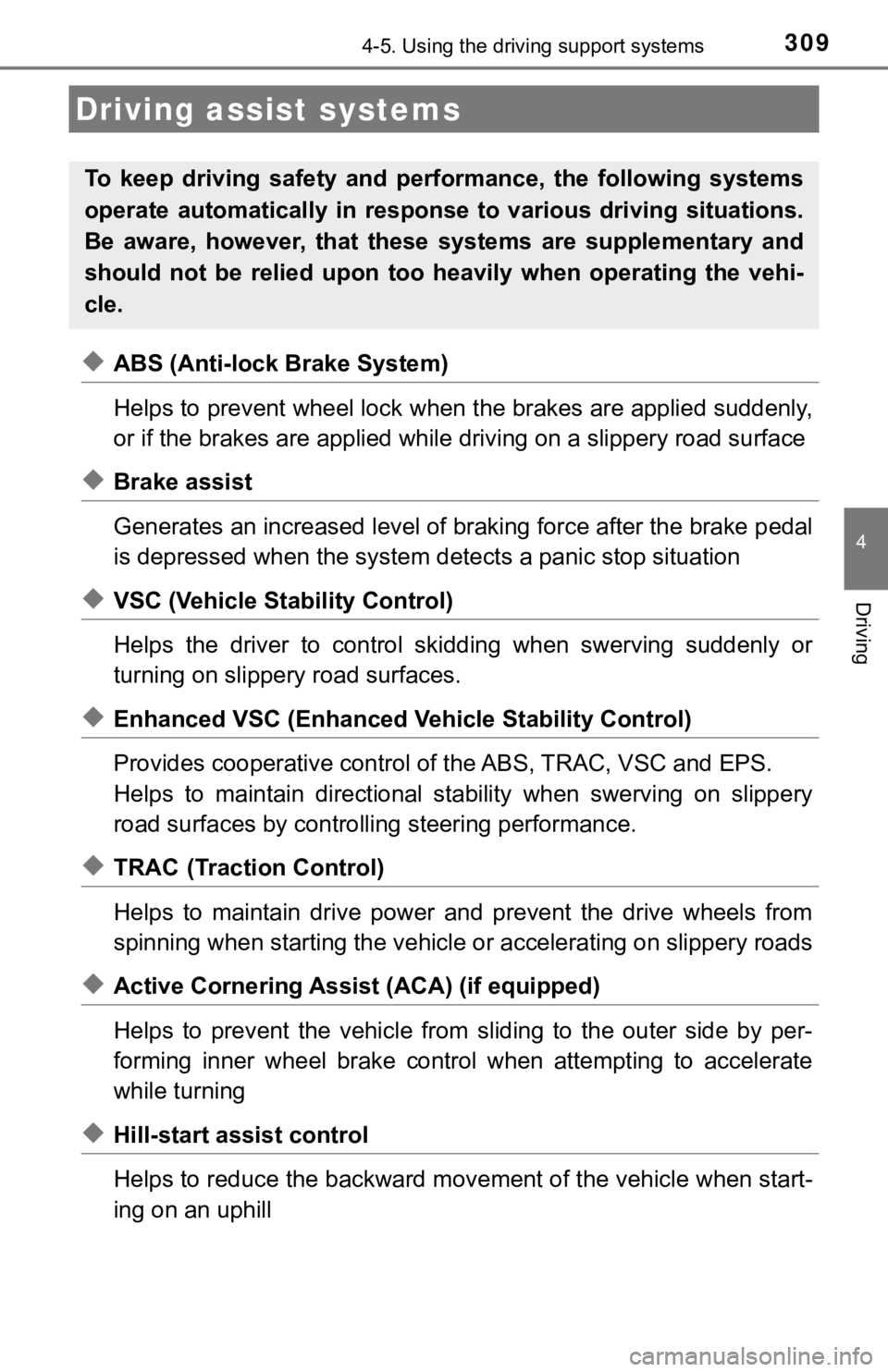
3094-5. Using the driving support systems
4
Driving
◆ABS (Anti-lock Brake System)
Helps to prevent wheel lock when the brakes are applied suddenly,
or if the brakes are applied while driving on a slippery road surface
◆Brake assist
Generates an increased level of braking force after the brake pedal
is depressed when the system detects a panic stop situation
◆VSC (Vehicle Stability Control)
Helps the driver to control skidding when swerving suddenly or
turning on slippery road surfaces.
◆Enhanced VSC (Enhanced Vehicle Stability Control)
Provides cooperative control of the ABS, TRAC, VSC and EPS.
Helps to maintain directional stability when swerving on slippery
road surfaces by controlling steering performance.
◆TRAC (Traction Control)
Helps to maintain drive power and prevent the drive wheels from
spinning when starting the vehicle or accelerating on slippery roads
◆Active Cornering Assist (ACA) (if equipped)
Helps to prevent the vehicle from sliding to the outer side by per-
forming inner wheel brake control when attempting to accelerate
while turning
◆Hill-start assist control
Helps to reduce the backward movement of the vehicle when start-
ing on an uphill
Driving assist systems
To keep driving safety and performance, the following systems
operate automatically in response to various driving situations.
Be aware, however, that these systems are supplementary and
should not be relied upon too heavily when operating the vehi-
cle.
Page 310 of 548
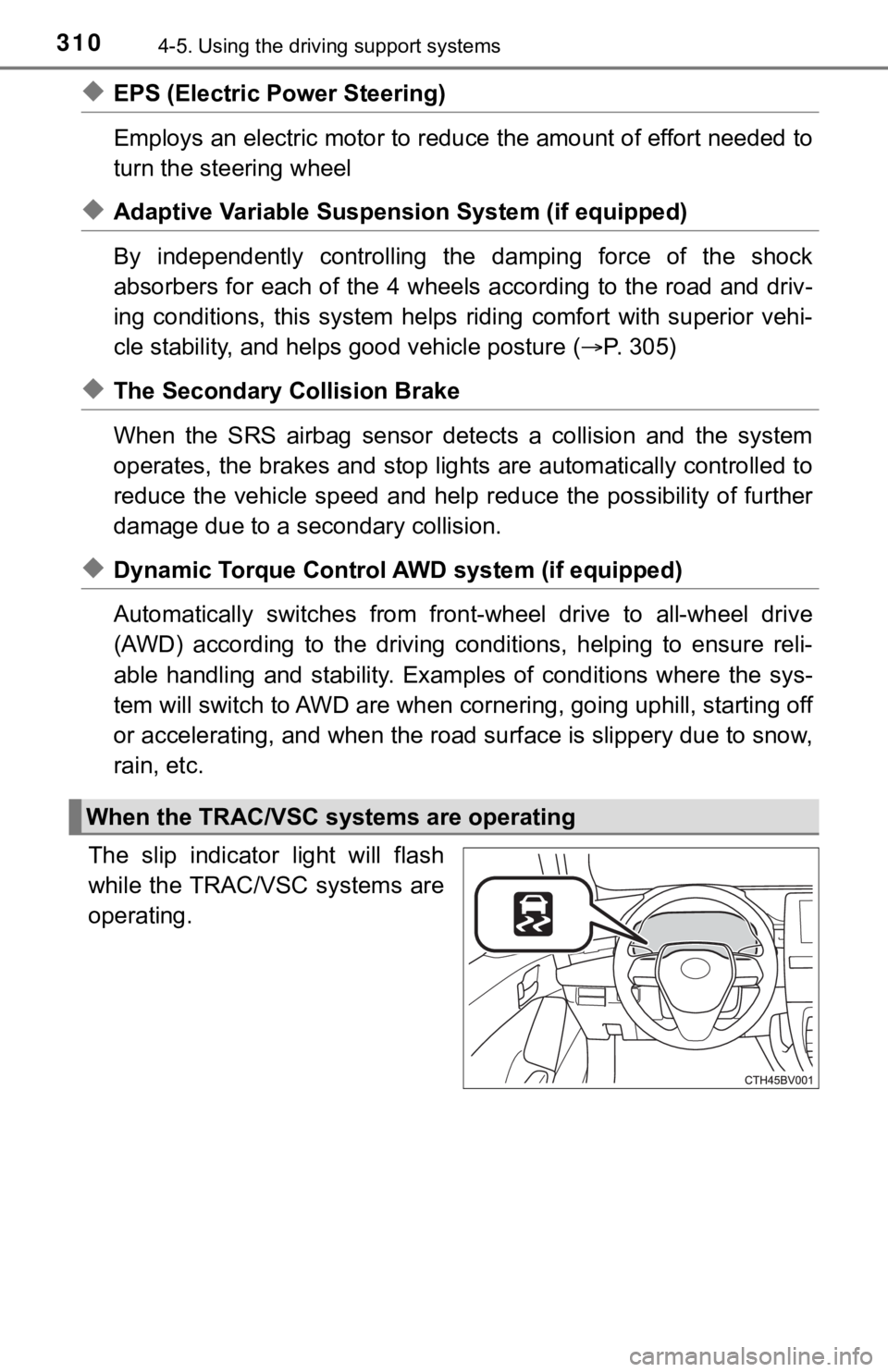
3104-5. Using the driving support systems
◆EPS (Electric Power Steering)
Employs an electric motor to reduce the amount of effort needed to
turn the steering wheel
◆Adaptive Variable Suspension System (if equipped)
By independently controlling the damping force of the shock
absorbers for each of the 4 wheels according to the road and driv-
ing conditions, this system helps riding comfort with superior vehi-
cle stability, and helps good vehicle posture (P. 3 0 5 )
◆The Secondary Collision Brake
When the SRS airbag sensor detects a collision and the system
operates, the brakes and stop lights are automatically controlled to
reduce the vehicle speed and help reduce the possibility of further
damage due to a secondary collision.
◆Dynamic Torque Control AWD system (if equipped)
Automatically switches from front-wheel drive to all-wheel drive
(AWD) according to the driving conditions, helping to ensure reli-
able handling and stability. Examples of conditions where the sys-
tem will switch to AWD are when cornering, going uphill, starting off
or accelerating, and when the road surface is slippery due to snow,
rain, etc.
The slip indicator light will flash
while the TRAC/VSC systems are
operating.
When the TRAC/VSC systems are operating